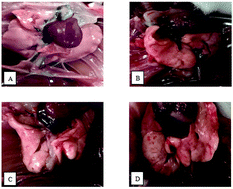Effects of indoor coal fine particulate matter on the expression levels of inflammatory factors in ovalbumin-induced mice†
Abstract
Objective: Cooking and heating with coal is the main source of household air pollution in acid rain-plagued areas of China and is a leading contributor to disease burden. In this study, we investigated the adverse effects of exposure to indoor fine particulate matter emission from coal combustion on the expression levels of inflammatory factors in ovalbumin (OVA)-induced mice. Methods: Forty BALB/c male mice were randomly divided into four groups (control group, PM2.5 group, OVA group, and OVA + PM2.5 group; n = 10) and treated with ovalbumin (OVA) or PM2.5, alone or together. Interleukin-4 (IL-4), interleukin-7 (IL-7), interleukin-8 (IL-8), interleukin-17 (IL-17), transforming growth factor β1 (TGF-β1), and interferon γ (IFN-γ) protein expression levels were measured in bronchoalveolar lavage fluid (BALF). Additionally, serum immunoglobulin (Ig) IgE and IgG1 levels were measured. The mRNA expression levels of IL-7 and IFN-γ in pulmonary tissue were also analyzed. Bronchoalveolar lavage (BAL), inflammatory cell counts, and histopathological examinations were also performed. Results: Exposure to PM2.5 + OVA induced abnormal pathological changes and inflammatory responses in lungs compared to the control. The levels of IL-4, IL-7, IL-8 and IL-17 in BALF from the OVA + PM2.5 group were higher than those in BALF from the control group, OVA group, and PM2.5 group (P < 0.05). PM2.5 plus OVA significantly raised the serum IgE and IgG1 levels compared with the control group. An increasing IL-7 mRNA trend was found among the treatment groups (P < 0.05). The expression level of IFN-γ mRNA was significantly higher in the control group than in the other 3 groups (P < 0.05). Conclusion: Indoor coal PM2.5 was sufficient by itself to cause inflammatory cellular infiltration of pulmonary tissue, leading to organelle injury and physiological structure change. Additionally, it promoted the occurrence and development of asthma by influencing the expression levels of IL-7 and various relevant inflammatory factors (such as IL-4 and IL-8) and changing the equilibrium between Treg and Th17 cells.



 Please wait while we load your content...
Please wait while we load your content...